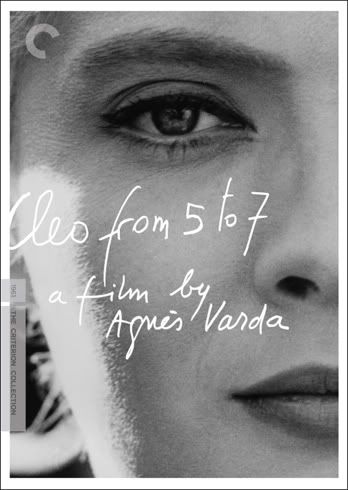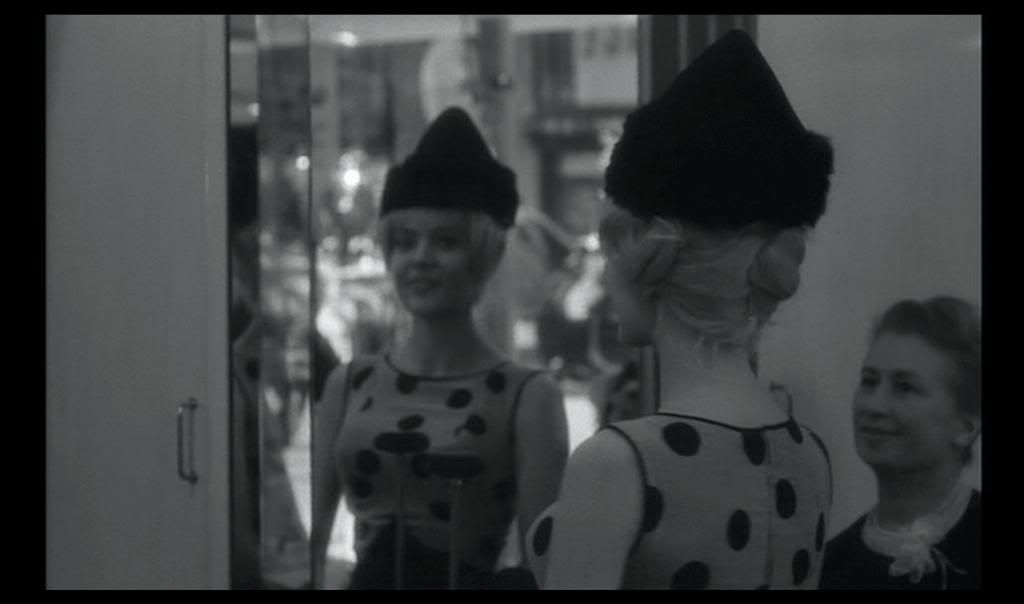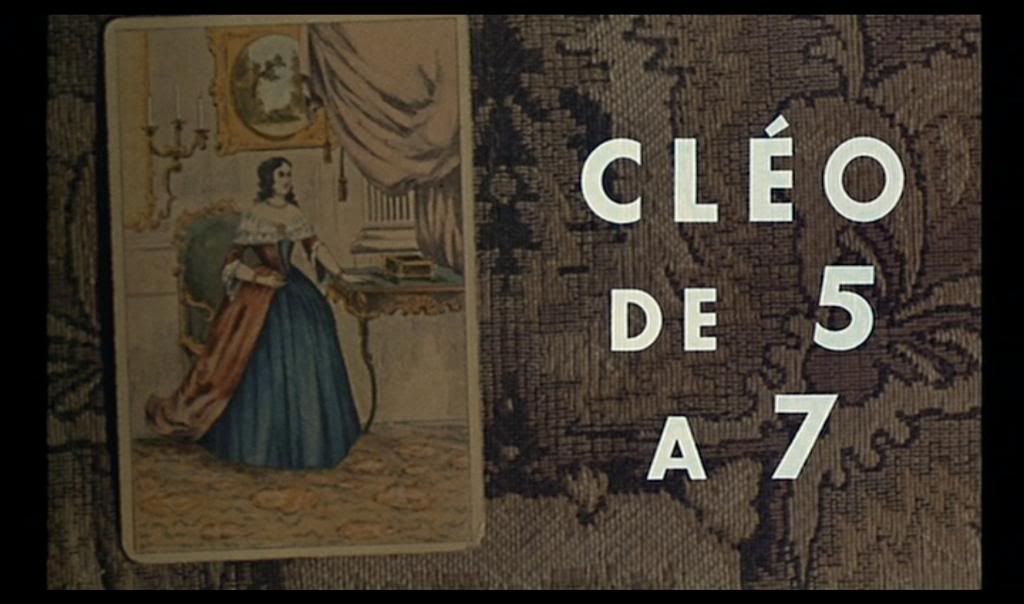By Andrew Chan Agnès Varda’s Cléo from 5 to 7, the film that put the “Grandmother of the French New Wave” on the international map, follows a pop singer (Corinne Marchand) through the streets of Paris as she awaits medical results that will report the severity of her cancer. Captured in approximate real time, her journey begins in a fortune teller’s office; within minutes, a foreboding tarot reading has her convinced she’s done for. But the film that follows is never chained to the heroine’s sense of impending doom. From start to finish, Cléo is a remarkably tonic portrait of urban anxiety, the sloth of the privileged, and the hazards of day-to-day, hour-to-hour living. Usually identified with the more serious and radical Left Bank division of the New Wave (which also included Alain Resnais and Chris Marker), Varda adopts the free-spirited attitude of Truffaut and Godard’s earliest popular successes, resulting in a film that is both a study in stylistic possibilities and a valentine to urban life.
Agnès Varda’s Cléo from 5 to 7, the film that put the “Grandmother of the French New Wave” on the international map, follows a pop singer (Corinne Marchand) through the streets of Paris as she awaits medical results that will report the severity of her cancer. Captured in approximate real time, her journey begins in a fortune teller’s office; within minutes, a foreboding tarot reading has her convinced she’s done for. But the film that follows is never chained to the heroine’s sense of impending doom. From start to finish, Cléo is a remarkably tonic portrait of urban anxiety, the sloth of the privileged, and the hazards of day-to-day, hour-to-hour living. Usually identified with the more serious and radical Left Bank division of the New Wave (which also included Alain Resnais and Chris Marker), Varda adopts the free-spirited attitude of Truffaut and Godard’s earliest popular successes, resulting in a film that is both a study in stylistic possibilities and a valentine to urban life.
Varda has stated that Cléo marked the first time she was able to reconcile her interest in the artificial, reconstructive properties of film with the medium’s capacity for authentically documenting the real world. This tension between the natural and the fabricated echoes not only in Varda’s stylistic flourishes (her idiosyncratic editing; her thrilling mixtures of genre) but also in the personality and predicament of her title character. Has there ever been a tragic heroine as unimposing as Cléo, or a depiction of illness as deliberately on-the-surface as in this film? Varda commits her first transgression by setting Cléo during what she admits are the raciest two hours in everyday French life, that period typically set aside for an evening roll in the hay. The film departs from our expectations of how the ill should be represented onscreen, the departure being particularly jarring because Varda introduces that weighty word “cancer” right off the bat. The audience’s immediate desire is to sympathize with Cléo, to heroize her, and to be helped along by some wholesome, old-fashioned melodrama. Instead, we find Cléo concerned about her potential loss of youth and beauty, constantly staring at herself in the endless hall of mirrors formed by the shop windows of Paris. Soon enough, we find her concerns pushed to the film’s margins time and again by more frivolous attractions. By surrounding Cléo in an environment of blithe obliviousness, Varda would have us convinced that the central drama here—the gut-wrenching anticipation of destiny; the misfortune of a possibly premature death—is of no real import. This unsentimental strategy allows us to discern one of the central issues laid out in the film, which concerns the rules of public emotional display. How does a film (or a person) weigh private fears against the social (and even political) priorities of the world? In one scene, Cléo walks into a restaurant for the sole purpose of playing her latest song on the jukebox to gauge the customers’ (largely indifferent) reactions. Moments later, she is riding in a taxi, hearing celebrity news about the recovery of Édith Piaf from surgery, and world news about the Algerian conflict. In this clever juxtaposition of audio, we are confronted with the fundamentally feminist question of where an individual woman’s anxieties stand in the grand scale of a busy, tragic world, as well as the humanist question of how we look outside ourselves without our personal suffering being illegitimated.
By surrounding Cléo in an environment of blithe obliviousness, Varda would have us convinced that the central drama here—the gut-wrenching anticipation of destiny; the misfortune of a possibly premature death—is of no real import. This unsentimental strategy allows us to discern one of the central issues laid out in the film, which concerns the rules of public emotional display. How does a film (or a person) weigh private fears against the social (and even political) priorities of the world? In one scene, Cléo walks into a restaurant for the sole purpose of playing her latest song on the jukebox to gauge the customers’ (largely indifferent) reactions. Moments later, she is riding in a taxi, hearing celebrity news about the recovery of Édith Piaf from surgery, and world news about the Algerian conflict. In this clever juxtaposition of audio, we are confronted with the fundamentally feminist question of where an individual woman’s anxieties stand in the grand scale of a busy, tragic world, as well as the humanist question of how we look outside ourselves without our personal suffering being illegitimated.
Whenever Varda decides to bring on the old-school heartache, she does so using the most transparently artificial means. On the rare occasions that we are allowed to plunge into Cléo’s psyche, we either hear her thoughts in voiceover, or experience her fear through a series of jump-cuts. The first time Cléo breaks into tears is exactly the point at which the film’s emotional expression and its transparency as film collide. In one of the most astonishing scenes, the camera starts off observing Cléo at rehearsal, slides in to frame her in the manner of a musical number, then quickly zooms out to jerk the audience back into the film’s “standard” layer of reality. Real-time structure always positions a movie at the center of cinema’s oldest genre division: the split between documentary and fiction which Varda has mined throughout her career. Approximations of “real time” in movies are usually undertaken with the intent of establishing a heightened reality. But attempts at this challenging stunt are few because, no matter how realistic cinema may pretend to be, it always exists in a separate universe, one whose sense of time moves according to the characters’ emotions or the director’s idea of what will keep an audience interested. As a gimmick, real time holds such fascination precisely because it is so confused about what it wants to achieve: while in theory it strives for slice-of-life naturalism, in actuality it can never divorce itself from the wish to be audacious, pyrotechnic, virtuosic—the same wish that, to a certain extent, underlies all our notions about the magic of cinema.
Real-time structure always positions a movie at the center of cinema’s oldest genre division: the split between documentary and fiction which Varda has mined throughout her career. Approximations of “real time” in movies are usually undertaken with the intent of establishing a heightened reality. But attempts at this challenging stunt are few because, no matter how realistic cinema may pretend to be, it always exists in a separate universe, one whose sense of time moves according to the characters’ emotions or the director’s idea of what will keep an audience interested. As a gimmick, real time holds such fascination precisely because it is so confused about what it wants to achieve: while in theory it strives for slice-of-life naturalism, in actuality it can never divorce itself from the wish to be audacious, pyrotechnic, virtuosic—the same wish that, to a certain extent, underlies all our notions about the magic of cinema.
The most famous examples of real-time experimentation have a decidedly non-naturalistic effect: Hitchcock’s Rope looks staged; Sokurov’s Russian Ark is sublime and hallucinatory; Linklater’s Before Sunset practically swoons as each second passes by. As in life, the typical film takes time’s passage for granted. But in real time, that passage is isolated and can become more entrancing than even the visual, spatial or aural qualities of a film. In Cléo, Varda invokes the concepts of realism and naturalism implicit in the use of real time, but she also does everything in her power to challenge them by slicing up the flow of time with her sometimes startling edits, and saving the film’s longest takes for the end so that they feel like a breath of fresh air, or a sigh of relief. Cléo moves in sections, with each new chapter title announcing not just the starting but also the ending time of a sequence. This formalist gesture attempts to toll us back to our conception of the film as an exercise in realism. But the principal delight is in watching Varda break her own rules. She has never been a minimalist, and far from being an attempt at “pure,” aesthetically chastened cinema, this film makes its audience aware of the many tools that lie at a director’s disposal. Beginning with the transition from color to black-and-white in the film’s first chapter, we are made conscious of the wide assortment of tricks being played, and as Varda adds on fractured editing, Michel Legrand’s lovely score, claustrophobic art direction, and collage-like bits of sound design, we get the sense that each moviemaking mechanism constitutes another layer of (or an additional distance from) reality. As much as Breathless or Shoot the Piano Player, Cléo is built on a relationship to movie-loving culture. Not only does the film feature cameos from Godard and Anna Karina, but these appearances occur in their very own set-piece: a film within the film. The mounting joy we feel in the final scenes is plugged directly into our cinephilia, as the film becomes reminiscent of great movies that were made before it (particularly Murnau’s Sunrise and Minnelli’s The Clock) and after it (Before Sunset).
Cléo moves in sections, with each new chapter title announcing not just the starting but also the ending time of a sequence. This formalist gesture attempts to toll us back to our conception of the film as an exercise in realism. But the principal delight is in watching Varda break her own rules. She has never been a minimalist, and far from being an attempt at “pure,” aesthetically chastened cinema, this film makes its audience aware of the many tools that lie at a director’s disposal. Beginning with the transition from color to black-and-white in the film’s first chapter, we are made conscious of the wide assortment of tricks being played, and as Varda adds on fractured editing, Michel Legrand’s lovely score, claustrophobic art direction, and collage-like bits of sound design, we get the sense that each moviemaking mechanism constitutes another layer of (or an additional distance from) reality. As much as Breathless or Shoot the Piano Player, Cléo is built on a relationship to movie-loving culture. Not only does the film feature cameos from Godard and Anna Karina, but these appearances occur in their very own set-piece: a film within the film. The mounting joy we feel in the final scenes is plugged directly into our cinephilia, as the film becomes reminiscent of great movies that were made before it (particularly Murnau’s Sunrise and Minnelli’s The Clock) and after it (Before Sunset).
Lying underneath the film’s ostensible obsession with time is Varda’s carefree, pleasurable pacing. Where real time rendered Hitchcock stilted, it made Varda jazzier, certainly freer and more associative than in her carefully scripted debut, La Pointe Courte. Cléo shuffles along leisurely, big-hearted and receptive to all the distractions that come its way, at times falling into some of the most rapturous moments to be found in the Varda canon. Marchand’s performance hits its peak when Cléo, in her first moment of complete solitude, descends a set of stairs toward a park, singing and puckering her lips like the star of her own revue. In this late scene, we understand for the first time that—as much as Cléo’s outwardly driven personality and hunger for attention have been influenced by a culture that demands women be image-conscious—our heroine is also, at the end of the day, a natural born performer. Cléo isn’t the prototypical feminist classic chronicling a woman’s journey from submissiveness to assertiveness, or from silence to self-articulation. The film spends much of its time insisting upon its heroine’s superficiality, refusing to ennoble her even as she carries the burden of a ready-made martyr. The beauty of her ultimate revelation is that, even though it results from an encounter with romance, it occurs modestly, without an ecstatic climax. Throughout the movie we’ve seen Cléo do nothing but perform and act out, so what strikes us most about this ending is her non-performing, and the fact that Varda and Marchand feel no need to compensate for her by bestowing the external markers of a wise, liberated female. Cléo and her true feelings remain mysterious and amorphous, breaking with a long tradition of histrionic silver-screen sufferers. In a film possessed of such youthful, quintessentially New Wave faith in the powers of cinematic style and technique, the director’s vision falls on the side of what cannot be filmed, or even said. Cléo—at the brink of what could be true love—finally stands on her own, proving herself to no one, including the film’s audience.
Cléo isn’t the prototypical feminist classic chronicling a woman’s journey from submissiveness to assertiveness, or from silence to self-articulation. The film spends much of its time insisting upon its heroine’s superficiality, refusing to ennoble her even as she carries the burden of a ready-made martyr. The beauty of her ultimate revelation is that, even though it results from an encounter with romance, it occurs modestly, without an ecstatic climax. Throughout the movie we’ve seen Cléo do nothing but perform and act out, so what strikes us most about this ending is her non-performing, and the fact that Varda and Marchand feel no need to compensate for her by bestowing the external markers of a wise, liberated female. Cléo and her true feelings remain mysterious and amorphous, breaking with a long tradition of histrionic silver-screen sufferers. In a film possessed of such youthful, quintessentially New Wave faith in the powers of cinematic style and technique, the director’s vision falls on the side of what cannot be filmed, or even said. Cléo—at the brink of what could be true love—finally stands on her own, proving herself to no one, including the film’s audience.
Image/Sound/Extras: Updating an earlier Criterion edition issued in 2000, this new DVD of Cléo from 5 to 7 (available only as part of the magnificent package 4 by Agnès Varda) features a restored digital transfer, as well as the set’s largest treasure trove of supplementary material. A good portion of these extras are dedicated to emphasizing the film’s intimate sense of place. In one 35-minute featurette, Varda interviews Corinne Marchand and Antoine Bourseiller at the locations seen in the final sequences of the film. In another, we are offered a swift trip by motorcycle through present-day Paris, recreating Cléo’s 90-minute journey through the city. The disc’s most amusing curio is an excerpt from a 1993 French TV interview, in which Varda praises Madonna’s “natural” acting ability, and the pop-star herself explains why she pursued the role of Cléo in an American remake that never got off the ground.
Inexplicably buried at the bottom of the DVD cover’s list of special features, Varda’s 1958 short film L’opéra Mouffe is actually one of the best discoveries the entire box-set has to offer. Introducing itself as a diary of the everyday impressions of a pregnant woman, the film (which is silent except for its musical soundtrack) succeeds as both poem and document. Scenes of naked young lovers in bed and the elderly in Paris’ Rue Mouffetarde market are mixed with astonishing images, associations, and analogies—a huge melon being hollowed out; a baby chick wriggling in a broken light bulb—that evoke both the miraculousness and awkwardness of birth. Perhaps Varda’s numerous short films deserved a fifth disc all to themselves; L’opéra surely warrants its own essay in the collection’s accompanying booklet, not only for the way it suggests Varda’s other vocations as a photojournalist and an installation artist, but also for its rare, personal take on a specifically female experience. As in much of her earlier work, the gravity of Varda’s subject is offset by a surprising lightness and humor, made possible by a director absorbed as much in the local charms of her film’s setting as she is in her own thoughts.
Andrew Chan is a poet and film critic currently studying at UNC-Chapel Hill. He is the creator of the blog Movie Love.
Monday, January 1, 2007
The Criterion Collection #73: Cléo from 5 to 7
Labels:
Agnès Varda,
Andrew Chan,
Cléo from 5 to 7
Subscribe to:
Post Comments (Atom)
No comments:
Post a Comment